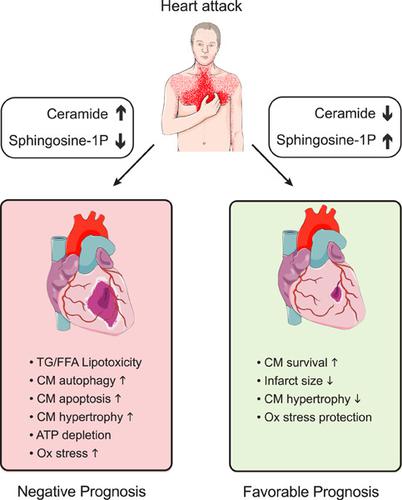当前位置:
X-MOL 学术
›
J. Cell. Physiol.
›
论文详情
Our official English website, www.x-mol.net, welcomes your
feedback! (Note: you will need to create a separate account there.)
The antithetic role of ceramide and sphingosine‐1‐phosphate in cardiac dysfunction
Journal of Cellular Physiology ( IF 4.5 ) Pub Date : 2021-01-11 , DOI: 10.1002/jcp.30235 Federica Cirillo 1 , Marco Piccoli 1 , Andrea Ghiroldi 1 , Michelle M Monasky 2 , Paola Rota 3 , Paolo La Rocca 4 , Adriana Tarantino 1, 2 , Sara D'Imperio 1, 2 , Paola Signorelli 5 , Carlo Pappone 2, 6 , Luigi Anastasia 1, 6
Journal of Cellular Physiology ( IF 4.5 ) Pub Date : 2021-01-11 , DOI: 10.1002/jcp.30235 Federica Cirillo 1 , Marco Piccoli 1 , Andrea Ghiroldi 1 , Michelle M Monasky 2 , Paola Rota 3 , Paolo La Rocca 4 , Adriana Tarantino 1, 2 , Sara D'Imperio 1, 2 , Paola Signorelli 5 , Carlo Pappone 2, 6 , Luigi Anastasia 1, 6
Affiliation

|
Cardiovascular diseases (CVDs) are the leading cause of death globally and the number of cardiovascular patients, which is estimated to be over 30 million in 2018, represent a challenging issue for the healthcare systems worldwide. Therefore, the identification of novel molecular targets to develop new treatments is an ongoing challenge for the scientific community. In this context, sphingolipids (SLs) have been progressively recognized as potent bioactive compounds that play crucial roles in the modulation of several key biological processes, such as proliferation, differentiation, and apoptosis. Furthermore, SLs involvement in cardiac physiology and pathophysiology attracted much attention, since these molecules could be crucial in the development of CVDs. Among SLs, ceramide and sphingosine‐1‐phosphate (S1P) represent the most studied bioactive lipid mediators, which are characterized by opposing activities in the regulation of the fate of cardiac cells. In particular, maintaining the balance of the so‐called ceramide/S1P rheostat emerged as an important novel therapeutical target to counteract CVDs. Thus, this review aims at critically summarizing the current knowledge about the antithetic roles of ceramide and S1P in cardiomyocytes dysfunctions, highlighting how the modulation of their metabolism through specific molecules, such as myriocin and FTY720, could represent a novel and interesting therapeutic approach to improve the management of CVDs.
中文翻译:

神经酰胺和 1-磷酸鞘氨醇在心功能障碍中的对抗作用
心血管疾病 (CVD) 是全球主要的死亡原因,心血管患者的数量估计在 2018 年超过 3000 万,对全球医疗保健系统来说是一个具有挑战性的问题。因此,识别新的分子靶标以开发新的治疗方法是科学界面临的持续挑战。在这种情况下,鞘脂 (SL) 已逐渐被认为是有效的生物活性化合物,在调节增殖、分化和细胞凋亡等几个关键生物过程中起着至关重要的作用。此外,SLs 参与心脏生理学和病理生理学引起了很多关注,因为这些分子在 CVD 的发展中可能是至关重要的。在 SL 中,神经酰胺和 1-磷酸鞘氨醇 (S1P) 是研究最多的生物活性脂质介质,其特征是在调节心肌细胞命运方面具有相反的活性。特别是,维持所谓的神经酰胺/S1P 变阻器的平衡成为对抗 CVD 的重要新治疗靶点。因此,本综述旨在批判性地总结目前关于神经酰胺和 S1P 在心肌细胞功能障碍中的对抗作用的知识,强调如何通过特定分子(如 myriocin 和 FTY720)来调节它们的代谢,代表一种新颖有趣的治疗方法,以改善心肌细胞功能障碍。心血管疾病的管理。维持所谓的神经酰胺/S1P 变阻器的平衡成为对抗 CVD 的重要新治疗靶点。因此,本综述旨在批判性地总结目前关于神经酰胺和 S1P 在心肌细胞功能障碍中的对抗作用的知识,强调如何通过特定分子(如 myriocin 和 FTY720)来调节它们的代谢,代表一种新颖有趣的治疗方法,以改善心肌细胞功能障碍。心血管疾病的管理。维持所谓的神经酰胺/S1P 变阻器的平衡成为对抗 CVD 的重要新治疗靶点。因此,本综述旨在批判性地总结目前关于神经酰胺和 S1P 在心肌细胞功能障碍中的对抗作用的知识,强调如何通过特定分子(如 myriocin 和 FTY720)来调节它们的代谢,代表一种新颖有趣的治疗方法,以改善心肌细胞功能障碍。心血管疾病的管理。
更新日期:2021-01-11
中文翻译:

神经酰胺和 1-磷酸鞘氨醇在心功能障碍中的对抗作用
心血管疾病 (CVD) 是全球主要的死亡原因,心血管患者的数量估计在 2018 年超过 3000 万,对全球医疗保健系统来说是一个具有挑战性的问题。因此,识别新的分子靶标以开发新的治疗方法是科学界面临的持续挑战。在这种情况下,鞘脂 (SL) 已逐渐被认为是有效的生物活性化合物,在调节增殖、分化和细胞凋亡等几个关键生物过程中起着至关重要的作用。此外,SLs 参与心脏生理学和病理生理学引起了很多关注,因为这些分子在 CVD 的发展中可能是至关重要的。在 SL 中,神经酰胺和 1-磷酸鞘氨醇 (S1P) 是研究最多的生物活性脂质介质,其特征是在调节心肌细胞命运方面具有相反的活性。特别是,维持所谓的神经酰胺/S1P 变阻器的平衡成为对抗 CVD 的重要新治疗靶点。因此,本综述旨在批判性地总结目前关于神经酰胺和 S1P 在心肌细胞功能障碍中的对抗作用的知识,强调如何通过特定分子(如 myriocin 和 FTY720)来调节它们的代谢,代表一种新颖有趣的治疗方法,以改善心肌细胞功能障碍。心血管疾病的管理。维持所谓的神经酰胺/S1P 变阻器的平衡成为对抗 CVD 的重要新治疗靶点。因此,本综述旨在批判性地总结目前关于神经酰胺和 S1P 在心肌细胞功能障碍中的对抗作用的知识,强调如何通过特定分子(如 myriocin 和 FTY720)来调节它们的代谢,代表一种新颖有趣的治疗方法,以改善心肌细胞功能障碍。心血管疾病的管理。维持所谓的神经酰胺/S1P 变阻器的平衡成为对抗 CVD 的重要新治疗靶点。因此,本综述旨在批判性地总结目前关于神经酰胺和 S1P 在心肌细胞功能障碍中的对抗作用的知识,强调如何通过特定分子(如 myriocin 和 FTY720)来调节它们的代谢,代表一种新颖有趣的治疗方法,以改善心肌细胞功能障碍。心血管疾病的管理。











































 京公网安备 11010802027423号
京公网安备 11010802027423号